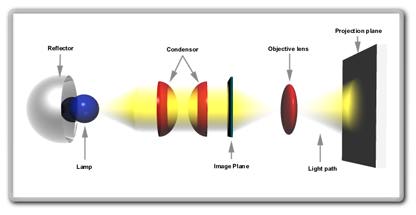This page is primarily intended for those not so familiar with using or making their own glass
gobos.
First, a glance at an example for a projector commonly used in theaters and TV studios:
Light from the lamp is passed through a condenser lens set to make the most use of the light
available, and to create a parallel beam of light that will pass through the gobos image area.
Then the light is focused so that the image will appear at the projection plane.
The image should be placed at the image plane so that, for example, a text that is readable at
the projection plane is also readable on the gobo seen from the condenser lens side, but
upside-down.
The temperature inside a profile lamp housing can reach several hundred degrees centigrade
so it is required that all materials used to hold the glass gobo can withstand the heat.
All projectors consist of the following basic items:
a light
source
condensor optics
an image
an objective lens
All efforts are made to use as much of the light emitted from the light source as possible, and to create a projection as correct as possible on a wall or a screen.
A common projector construction:

Light source
There are many different type of lamps on the market. Most common is the halogen lamp. The advantage of this type of lamp is that it is very simple to operate. They are driven by direct 220 volt or 110 volt AC. You could plug it in the wall. A more efficient type of lamp is the ARC-lamp. HMI, HBO, there are many variations of them but the common part is that they creates light from a spark (or arc) between two electrodes. These lamps are more efficient and produce more blue light, but need some kind of electronic ballast to operate, It is also much more difficult to regulate the light output.
Condensor
Condensor optics are used to collect the light from the source and focus it on the objective lens. Another important issue is to get as uniform light intensity as possible on the image. There are two ways to collect the light. The first way it to use an elliptical back reflector that has two focal points, one in the lamp and the other in the objective lens.
The other way is to collect the light by a lens or to lenses which focus the light into the objective lens.
A combination of these is to collect the light by an circular back reflector and focus the back light into the lamp. The emission from back and forward are superimposed and collected by the condensor optics that focus the light into the objective lens. This will double the output compared to if there were no back reflector.
Image
In the path of this light the image is put as near the condensor lens as possible. This is done because the diameter of the light beam is large there and the intensity is most uniform.
Objective lens
A projection will appear in the projection plane. It is a mirror copy of the image. It is also upside down. The quality of this image is depending strongly on the number of lens elements. An acromat lens will reduce the color errors that appear due to a single lens. Antireflex will also reduce the surface reflections that could cause unwanted light reflections, and reduce the output. Appr 5% of the light is lost from each lens surface due to reflections. Some projectors have the ability to zoom. This is done by moving two lenses independently. This will change the focal length.
The major problem concerning the gobo is the heat. The condensor lens blocks some of the IR-radiation and some convection of hot air. A forced air flow is always helpful to the heat problem. But most projectors could use the Beacon glass gobos and Beacon color gobos without need to protect the gobo.
Projector types on the market
Due to the increasing number of projector types on the market and that there are no standard in gobo sizes, we are supplying the most common diameters. If requested, there is no problem in manufacture custom sizes.